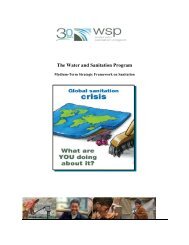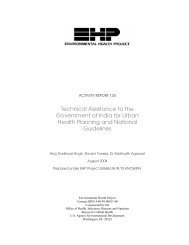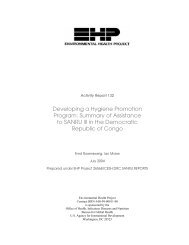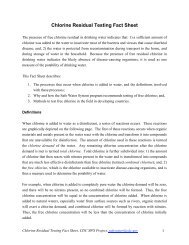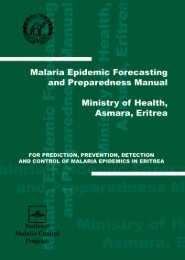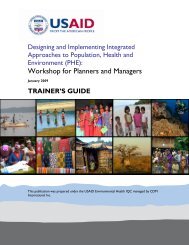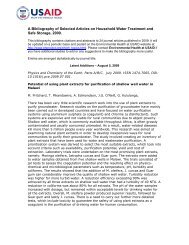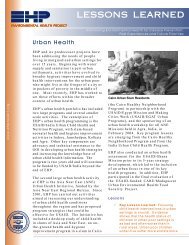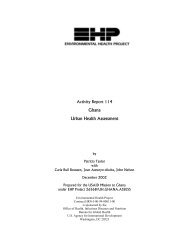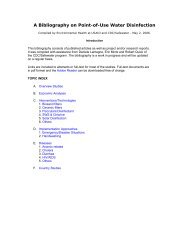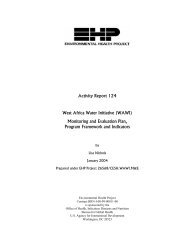Changing Glaciers and Hydrology in Asia - Environmental Health at ...
Changing Glaciers and Hydrology in Asia - Environmental Health at ...
Changing Glaciers and Hydrology in Asia - Environmental Health at ...
- No tags were found...
You also want an ePaper? Increase the reach of your titles
YUMPU automatically turns print PDFs into web optimized ePapers that Google loves.
contribution, compared to total runoff gener<strong>at</strong>ed below 2,000 m, is the follow<strong>in</strong>g: Indus, 151%;Brahmaputra, 27%; Ganges, 10%; Yangtze, 8% <strong>and</strong> Yellow, 8%. This shows the much highercontribution of glacier melt to the Indus than to other rivers. This recent work of Immerzeel etal. represents an important step forward <strong>in</strong> underst<strong>and</strong><strong>in</strong>g the regional hydrology of the gre<strong>at</strong>erHimalaya.In Central <strong>Asia</strong>, Severskiy (2009) reports th<strong>at</strong> glaciers lost volume <strong>at</strong> about 1% per year dur<strong>in</strong>gthe last 35-40 years of the 20 th century. Such losses will result <strong>in</strong> significant changes <strong>in</strong> thehydrologic cycle as glacier runoff is responsible for 40-50% of discharge <strong>in</strong> the Tarim <strong>and</strong>Balkhash Bas<strong>in</strong>s (from Dolgush<strong>in</strong> <strong>and</strong> Osipova 1989, referenced <strong>in</strong> Kotlyakov <strong>and</strong> Severskiy2009). For the whole Tien Shan, the annual <strong>and</strong> summer fractions of glacier runoff areapproxim<strong>at</strong>ely 20 <strong>and</strong> 35% respectively (Aizen et al. 2006).In summary, a highly accur<strong>at</strong>e assessment of the significance of snow <strong>and</strong> glacier melt <strong>in</strong> theoverall <strong>Asia</strong>n river hydrology rema<strong>in</strong>s largely unaccomplished. There is reasonable confidence <strong>in</strong>st<strong>at</strong><strong>in</strong>g th<strong>at</strong> the contribution of glacier ice melt to the downstream hydrology is small <strong>in</strong> the east,<strong>and</strong> not expected to change <strong>in</strong> the next few decades. Contribution is considerably larger <strong>in</strong> thewest, but the total volume from glacier melt is still rel<strong>at</strong>ively small <strong>and</strong> there is no apparentreason to th<strong>in</strong>k th<strong>at</strong> it would change significantly <strong>in</strong> the next few decades. Although thecontribution from melt<strong>in</strong>g glacier ice to the hydrology of the lower reaches of mounta<strong>in</strong> rivers isrel<strong>at</strong>ively small, melt w<strong>at</strong>er <strong>in</strong>creases <strong>in</strong> significance as one moves upward <strong>in</strong> the bas<strong>in</strong> towardsthe source of th<strong>at</strong> melt w<strong>at</strong>er. However, societies th<strong>at</strong> have adjusted to this current m<strong>in</strong>imalvolume of melt w<strong>at</strong>er from glaciers are not likely to be <strong>in</strong> for any gre<strong>at</strong> surprises over the nextfew decades.Known <strong>and</strong>/or projected environmental impacts of glacier meltBecause knowledge is <strong>in</strong>complete about glacier melt <strong>and</strong> the r<strong>at</strong>es of melt, impacts (except as<strong>in</strong>dic<strong>at</strong>ed below) are uncerta<strong>in</strong>. However, glacier melt is occurr<strong>in</strong>g <strong>and</strong> will result, along withother hydrological changes, <strong>in</strong> impacts th<strong>at</strong> will be felt <strong>in</strong> the bas<strong>in</strong>s of rivers th<strong>at</strong> orig<strong>in</strong><strong>at</strong>e <strong>in</strong>High <strong>Asia</strong>. These impacts may be too much w<strong>at</strong>er (floods), too little w<strong>at</strong>er (droughts/ <strong>in</strong>creasedaridity), or w<strong>at</strong>er <strong>at</strong> different times (more early <strong>in</strong> the grow<strong>in</strong>g season/less l<strong>at</strong>e <strong>in</strong> the grow<strong>in</strong>gseason).A misconception sometimes found <strong>in</strong> the popular liter<strong>at</strong>ure expresses the concern th<strong>at</strong> therapid melt<strong>in</strong>g of glaciers alone will lead to c<strong>at</strong>astrophic flood<strong>in</strong>g downstream. This is physicallyimpossible. Glacier ice melt r<strong>at</strong>e under any reasonable warm<strong>in</strong>g scenario is rel<strong>at</strong>ively slow, <strong>and</strong>thus cannot, per se, cause floods. <strong>Environmental</strong> impacts come <strong>in</strong> the form of hazards associ<strong>at</strong>edwith two dist<strong>in</strong>ct types of GLOFs. Interest<strong>in</strong>gly, these types of floods can result from bothretre<strong>at</strong><strong>in</strong>g <strong>and</strong> advanc<strong>in</strong>g glaciers. The first type, a mora<strong>in</strong>e-dammed outburst flood, occurs whenlarge volumes of w<strong>at</strong>er build up beh<strong>in</strong>d the term<strong>in</strong>al mora<strong>in</strong>e of a rapidly melt<strong>in</strong>g, retre<strong>at</strong><strong>in</strong>gglacier <strong>and</strong> the mora<strong>in</strong>e dam fails. For example, <strong>in</strong> 1985 a glacier lake, Dig Tsho <strong>in</strong> the Khumburegion of Nepal, burst <strong>and</strong> the flood w<strong>at</strong>ers completely destroyed a nearly completed hydroelectricpower st<strong>at</strong>ion <strong>at</strong> Thame, some 12 km below Dig Tsho. Thirty houses, many hectares of25



